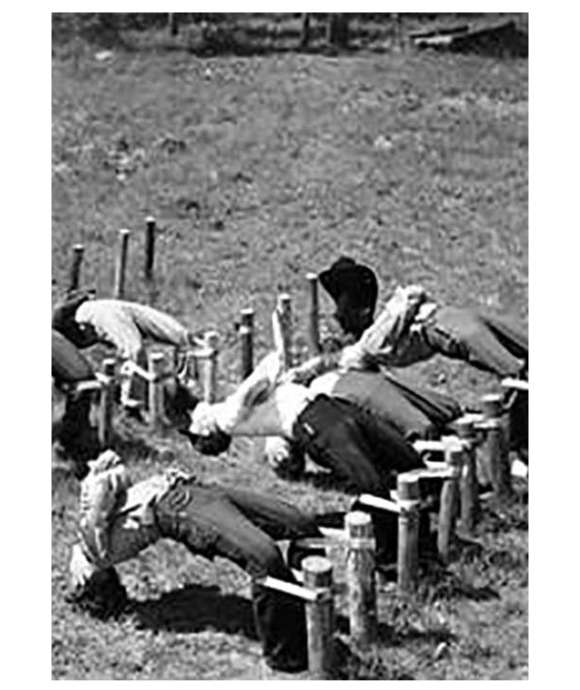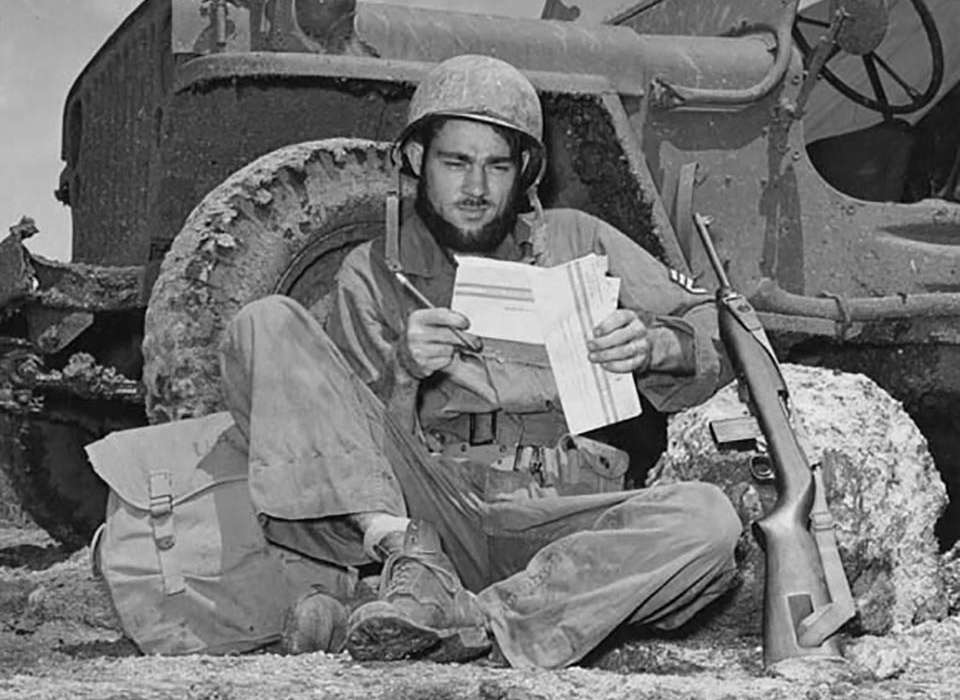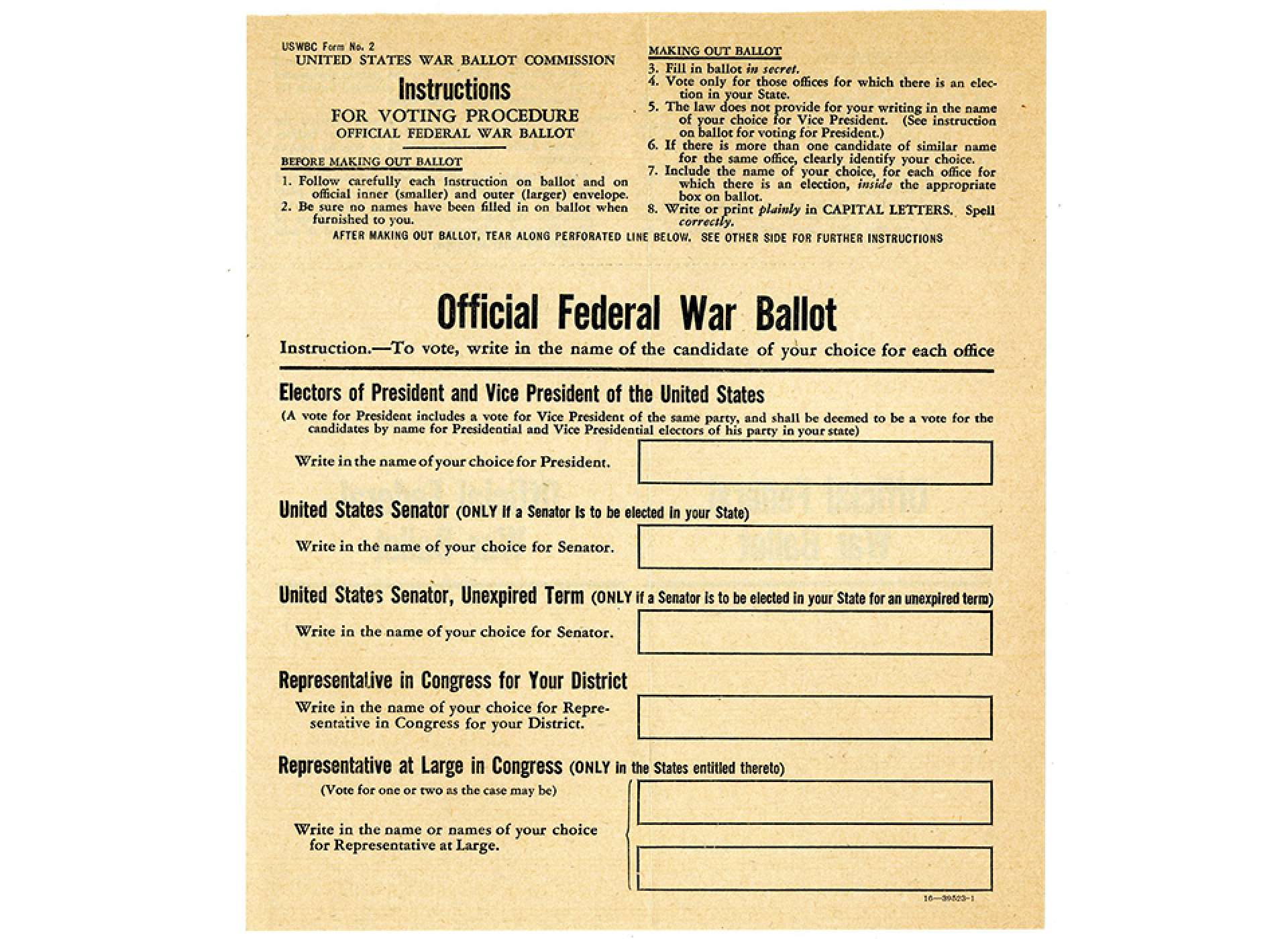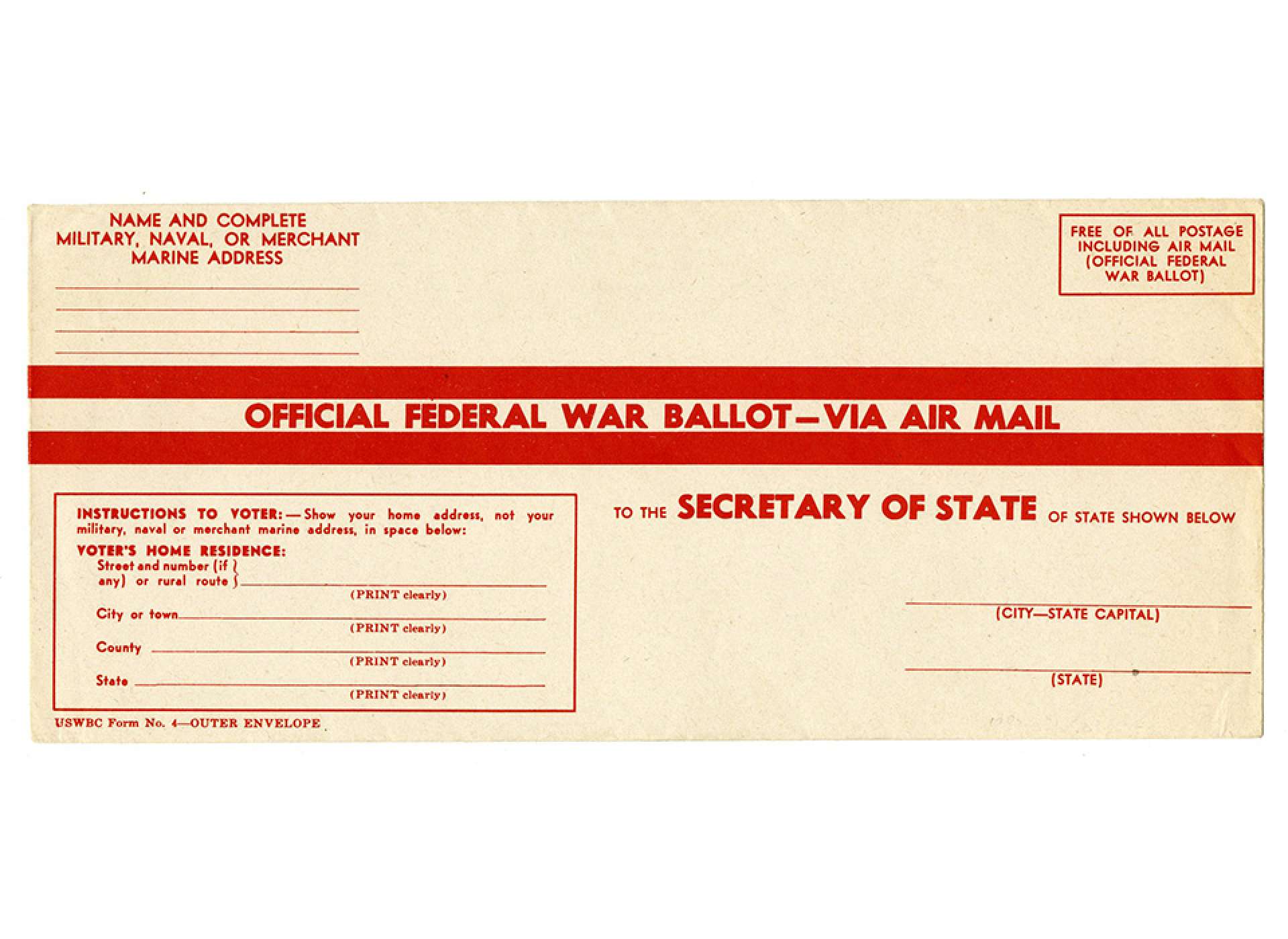Top image: Staff Sergeant Dale Blakeslee casts his ballot in the 1944 US election somewhere in the Marianas Islands. Courtesy United States Air Force.
During World War II, more than 16 million Americans served in uniform. Approximately 11.5 million men and women served overseas, and the remainder often served thousands of miles away from their homes even when stationed within the United States. To ensure that these service members continued to be represented in their government, Congress passed bills in 1942 and 1944 intended to guarantee that American soldiers could vote in wartime elections for federal offices. Although the bills fell short of their ambitious goal, the 1944 bill permitted millions of soldiers to cast absentee ballots in the federal election that year.
The idea of allowing soldiers to cast absentee ballots had a precedent in an earlier American war. During the Civil War, some states within the Union passed laws enabling soldiers to vote using mail-in ballots in the election of 1864. Other states sent commissioners into the field to record soldiers’ votes. Many politicians during the Civil War, however, feared that soldiers would blindly vote for their commander-in-chief, President Abraham Lincoln. As a result, some states did not make any provision for soldiers to vote. The state officials who willfully disenfranchised soldiers may have felt their actions were justified when Lincoln captured 78 percent of soldiers’ votes and 55 percent of the popular vote. After the war, most of the laws enabling soldiers to vote expired, and no provisions were made at the national level for soldiers to cast absentee ballots in the 1918 congressional elections during World War I.
The Soldier Voting Act of 1942 once again attempted to give soldiers the ability to vote, but it was not without controversy. Some legislators feared that the federal government’s attempt to create a uniform absentee ballot and dictate election procedures trespassed on states’ sovereignty. Yet many states’ election laws made no provision whatsoever for soldiers to vote using absentee ballots, and half a dozen states made no provision for absentee ballots at all. While nearly all congressmen agreed in principle that soldiers should be able to vote, some resisted having the federal government create a uniform procedure for enabling it.
Debate over the bill divided legislators along both partisan and regional lines. Initial drafts of the bill mandated that no soldier would be required to pay a poll tax or make any other type of payment in order to vote. This provision infuriated representatives of the eight southern states (all former members of the Confederacy) that continued to use poll taxes in order to disenfranchise African American voters. Some congressmen accused their southern colleagues of blocking the Soldier Voting Act’s passage just because it might benefit African Americans in uniform. Representative John Jennings of Tennessee vehemently declared that African Americans “are citizens of this country, they are its defenders, and they have the right to vote.” With less than two months to go before the election of 1942, Jennings and his allies finally secured the votes necessary to override supporters of the poll tax. The final bill was signed into law on September 16, 1942. Among the bill’s provisions, it guaranteed that “every individual absent from the place of his residence and serving in the land or naval forces of the United States” was entitled to vote in elections for federal offices.” It also contained a provision which stated that “No person in military service in time of war shall be required, as a condition of voting in any election… to pay any poll tax.”
In the wake of this improbable victory, the bill still failed to live up to its sponsors’ hopes. A mere 28,000 service members, out of nearly four million men and women in uniform in 1942, voted in the election. While the late passage of the bill gave states little time to prepare ballots and send them to soldiers, the bill also failed to make any provisions for soldiers serving overseas to vote. This omission stemmed from the opinion of War Department representatives, who informed Congress that the demands of wartime shipping and slow mail service overseas would preclude the return of overseas soldiers’ ballots by the election.
In response to the Soldier Voting Act’s abject failure, Congress sought to revise it in time for the November 1944 election. The War and Navy Departments supported the adoption of a universal ballot that would allow soldiers to write in the candidates they wished to vote for in federal elections. Although such a ballot required soldiers to know the names of the candidates they wished to support and did not allow them to vote in local elections, it enabled ballots to be printed and distributed before the final nominating conventions were held by each political party. A uniform ballot had the additional benefit of reducing weight and eliminating the need for soldiers to individually request a ballot.
Despite the advantages of a universal federal ballot, some congressmen again took issue with the proposal. President Franklin D. Roosevelt was seeking an unprecedented fourth term as president and his margin of victory in 1940, 5 million votes out of nearly 50 million votes cast, indicated that the estimated 9,225,000 Americans in the armed forces who were of voting age (at least 21 years old) could easily determine the 1944 presidential race. As polls suggested that a majority of American soldiers planned to return President Franklin D. Roosevelt to the White House, Republicans and conservative Democrats resisted measures that would make it easier for soldiers to vote.
Republican Senator Robert Taft of Ohio, the leading opponent of the bill, insisted that the ballots should bear the names of candidates for office. Taft and his colleagues believed that, given a blank ballot, many soldiers would vote for the only president they had known for the past 11 years. Taft also expressed his doubts that officials in Roosevelt’s government would facilitate a fair election, and he once again raised the issues of poll taxes and state voter registrations. Even though these obstacles had been overcome in the 1942 bill, Taft sought to reignite the debate in order to prevent the new bill’s passage. As Taft expected, southern senators joined him in opposing the bill and defending poll taxes. Louisiana Senator John Overton declared to his colleagues that “we have got to retain our constitutional rights to prescribe qualifications of electors, and for what reason? Because we are bound to maintain white supremacy in those States.” The debate dragged on into the spring of 1944 with both parties accusing the other of trying to manipulate the outcome of the presidential election through the bill.
The bill that finally passed in April 1944 appeased both sides by encouraging states to amend their own absentee ballot procedures to enable soldiers to vote. Alternatively, state governors could choose to adopt the “Official Federal War Ballot.” Ultimately, 20 states authorized the use of the ballot, which required soldiers to write the names of the candidates they wished to vote for. Incredibly, the bill stated that no ballot could be declared invalid even if a soldier made a mistake in writing a candidate’s name, provided that “the candidate intended by the voter is plainly identifiable.” This victory was marred by the fact that, unlike the Soldier Voting Act of 1942, the 1944 bill enabled states to collect poll taxes from soldiers.
-

The federal war ballot used in the 1944 election. Courtesy National Museum of American History.
-

The federal war ballot used in the 1944 election. Courtesy National Museum of American History.
It is difficult to accurately assess the full impact of the soldier vote in the 1944 election. Approximately 3.4 million absentee votes were cast in the 1944 election, with President Franklin D. Roosevelt winning reelection to a fourth term by a margin of slightly more than 3.5 million votes. Although the Soldier Voting Act of 1944 was a success compared to its earlier iteration, only 25 percent of service members voted in 1944 compared to more than 55 percent of the population as a whole. Nevertheless, the bill gave millions of men and women in uniform a voice in their government during a global war in which few soldiers of other nations enjoyed the same privilege.

Alternative Service: Conscientious Objectors and Civilian Public Service in World War II
During World War II, a new program gave young men who refused to wear a uniform other ways to serve their country.
Tyler Bamford
Tyler Bamford was the Sherry and Alan Leventhal Research Fellow at the Institute for the Study of War and Democracy at The National WWII Museum from 2019-2021. He obtained his PhD in history from Temple University and his BA in history from Lafayette College.
Cite this article:
MLA Citation:
APA Citation:
Chicago Style Citation:








![Max Fuchs, New York City cantor, sings as Rabbi Sydney [sic] Lefkowitz, Richmond, VA, conducts the first Jewish services from Germany.](/sites/default/files/styles/max_650x650/public/2025-10/image1.jpg)


